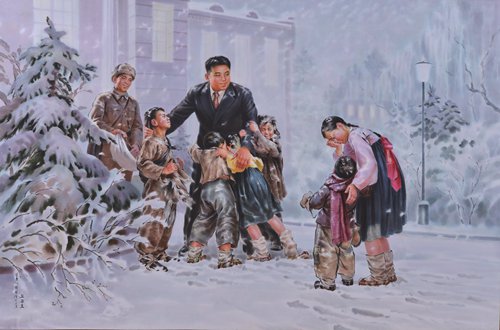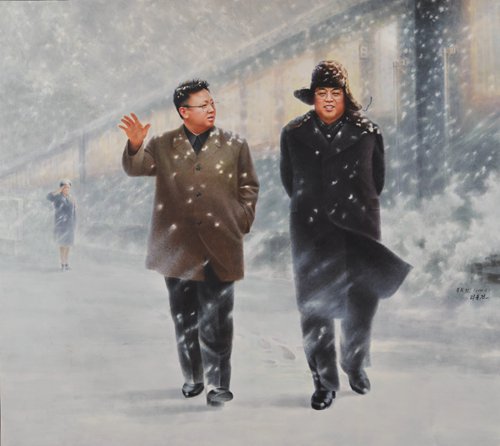


Embracing Orphansby Oh Gwang-ho Photo: Courtesy of the Motang International Museum of Arts

On the Way for the Peopleby Lee Dong-gun Photo: Courtesy of the Motang International Museum of Arts

A North Korean artist paints at the Motan International Museum of Arts in Beijing Photo: Courtesy of the Motang International Museum of Arts
"This is Mount Kumgang, a very saintly theme for North Korean artists," the museum guide introduced pointing at an oil landscape work at an exhibition held by the Motang International Museum of Arts, a private gallery famous for North Korean art.
Stroked in thick pigment, the painted mountains shone under the sunlight causing the entire painting to take on a lively air.
On January 10, the Beijing-based museum kicked off a retrospective exhibition of artworks by Hong Sung-chul, one of the most influential artists of the 20th century in North Korean art history.
Prior to the exhibition, the museum had just finished its first biennale dedicated to Korean painting, during which four portraits of famous leaders received a lot of attention. A popular theme for North Korean art, it is rare for such content to be exhibited outside the country.
"Although their work looks similar to Chinese paintings, North Korean artists combine more Western techniques and pursue a 3D effect when it comes to perspective and presentation of light and shadow," Ma Chunguang, curator of Motang Museum, told the Global Times on Wednesday.
"North Korean art has historical significance in that these works present the brand of an era. As the political development of the nation continues, these artworks will be considered part of North Korea's cultural heritage in the future."
Turning to North Korea
During the year 2016, China showed an increasing interest in art from around the world. Several high-profile acquisitions have many in the industry paying close attention to Chinese collectors when it comes to art auctions in 2017.
While the biggest buyers mainly focused on classic Chinese literati and big Western names, a group of collectors looked to North Korea, a mysterious land in the eyes of many Chinese.
"The first time I saw a North Korean painting, I was touched by its pure and tranquil temperament," Ma recalled. At the end of 2010, he bought the first painting of what would become a large collection of North Korean paintings, a lifelike tiger drawn by top ranking artist Kim Chul.
Kim works for the Mansudae Art Studio, the largest and most famous art production complex in North Korea. So far, the Mansudae Art Museum located in Beijing's 798 Art District is the only museum that the North Korean government has invested in overseas.
In April 2016, Ma became the exclusive partner of White Tiger, a state-owned art studio in North Korea. Motang employees also told the Global Times that the museum is also collaborating with Mansudae.
Taking on the market
Having worked in the art investment industry for more than 10 years, Ma thinks highly of North Korean art's market potential in China.
"Compared to most contemporary art works, North Korean paintings are easy to understand. Additionally, for some middle-aged Chinese, these paintings can bring back memories," Ma said.
Inheriting the art style of Soviet paintings, which is almost extinct in Russia and China nowadays, all North Korean art adopts an extreme socialist realism style.
Another factor is the relatively low price of these paintings. North Korean art has not been oversold.
Cui Xing, a folk art collector based in Dandong, Northeast China's Liaoning Province, just purchased a large amount of paintings by artists from the Mansudae Art Studio with the help of his friends.
Cui told the Global Times that the price of North Korean paintings so far is still inexpensive. "It's like the price of Chinese art during the 1970s and 1980s."
At present, Cui owns more than 100 North Korean paintings. According to him, some of the more expensive pieces in his collection are worth more than 100,000 yuan ($14,593), but the majority of them will only sell for several thousand or even a hundred yuan.
"The price of a thing depends on the wealth of the nation it belongs to. They [North Korean paintings] are experiencing the same thing that Chinese paintings went through," Cui said.
Unmatched skill
Although the prices of North Korean paintings remain low for now, that is sure to change because the "special conditions of the state" contribute to the high skill of North Korean artists.
"Most North Korean artists have received a good art education. They have high professional standards," Ma said. "Objectively speaking, they deserve to be sold at a higher price."
According to a September report by China News Weekly, in North Korea each artist has their own one-room studio. These studios have such ideal artificial lighting that windows are covered by curtains, while the walls are also soundproofed. This type of environment prevents many artists from being effected from external disturbances.
As all art institutions are state-owned in North Korea, the creation of art doesn't have to worry about pressures from the market, which has contributed to a more simple aesthetic in paintings.
"They don't need to worry about housing or living expenses. The government arranges all of this so they can focus on the creation of art," a Motang Museum employee told the Global Times.
 Fire brigade in Shanghai holds group wedding
Fire brigade in Shanghai holds group wedding Tourists enjoy ice sculptures in Datan Town, north China
Tourists enjoy ice sculptures in Datan Town, north China Sunset scenery of Dayan Pagoda in Xi'an
Sunset scenery of Dayan Pagoda in Xi'an Tourists have fun at scenic spot in Nanlong Town, NW China
Tourists have fun at scenic spot in Nanlong Town, NW China Harbin attracts tourists by making best use of ice in winter
Harbin attracts tourists by making best use of ice in winter In pics: FIS Alpine Ski Women's World Cup Slalom
In pics: FIS Alpine Ski Women's World Cup Slalom Black-necked cranes rest at reservoir in Lhunzhub County, Lhasa
Black-necked cranes rest at reservoir in Lhunzhub County, Lhasa China's FAST telescope will be available to foreign scientists in April
China's FAST telescope will be available to foreign scientists in April "She power" plays indispensable role in poverty alleviation
"She power" plays indispensable role in poverty alleviation Top 10 world news events of People's Daily in 2020
Top 10 world news events of People's Daily in 2020 Top 10 China news events of People's Daily in 2020
Top 10 China news events of People's Daily in 2020 Top 10 media buzzwords of 2020
Top 10 media buzzwords of 2020 Year-ender:10 major tourism stories of 2020
Year-ender:10 major tourism stories of 2020 No interference in Venezuelan issues
No interference in Venezuelan issues
 Biz prepares for trade spat
Biz prepares for trade spat
 Broadcasting Continent
Broadcasting Continent Australia wins Chinese CEOs as US loses
Australia wins Chinese CEOs as US loses